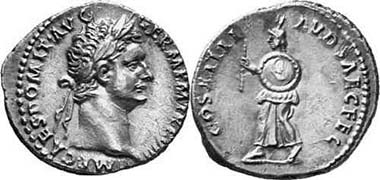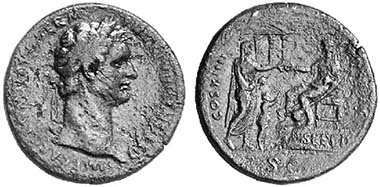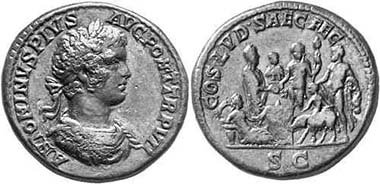In ancient Rome, a saeculum didn’t necessarily lasted 100 years. There was a difference between the civilian century with its 100 years and the natural saeculum: the natural saeculum changed when the gods sent the ignorant human beings a sign which was recognized as such by the council of priests of the quindecimviri sacris faciundis with the aid of the Sibylline Books.
There was, of course, room for speculation about the reading of a sign. Did the calf with its two heads really indicate that the saeculum was coming to an end? Was the unusually heavy thunderstorm whose thunderbolts torched a temple to be considered a sign? The case wasn’t always as obvious as it was at the end of the 8th saeculum when the blare of a trumpet, coming out of the blue, is said to have announced the end of that age.
Augustus considered the appearance of a comet in 17 B. C. reason enough to conduct his Saecular Games that very year, from May 30 to June 3. Claudius, the etruscologist doing research on the stars and historian on the emperor’s throne, complained about that date and celebrated the Saecular Games a second time, in A. D. 47. That made two dates for the Roman emperors to draw upon. Domitianus in his reign of course relied upon the Augustan cycle to celebrate the impressive three-day ceremony with public appeal in A. D. 88. The individual rites involved in this ceremony are annotated in detail on his coins.
Domitianus, 81-96. Denarius, 88. COS XIIII LVD SAEC FEC harbinger with round shield and rod walking l. RIC 117. From auction Gorny & Mosch 134 (2004), 2710.
Months prior to the festival, harbingers wearing ancient attires announced a “celebration no one has hitherto witnessed or will live to witness again.” (Suet. Claud. 21). Behind these words was the belief that an age, a saeculum, had passed when the last person who had witnessed the recent seacular festival had died and the earth had rejuvenated into an entirely new age. Then, when mankind had revolved entirely, the time had come to celebrate that saecular festival.
Domitianus, 81-96. Sestertius, 88. Rev. COS XIIII LVD SAEC Domitian sitting on a pedestal l., handing the means of expiation to a pater familias who had come with his son; on the pedestal SVF PD. RIC 376. From auction Gorny & Mosch 108 (2001), 1762.
Shortly before the celebration, all patres familiae in Rome were given sulphur, bitumen and torches so that every single house was cleansed ritually. On the day before the festival, the priests, including the emperor himself, accepted the first fruits, grain, beans and other field- and garden-fresh products from the people. The vegetable retailers are likely to have made good business that day since barely any Roman had still a little manor of his own outside town which provided him with first fruits of his own.
The actual festival consisted of a number of vivid enactments. In the first night, three black goats were sacrificed to the Moires on the Campus Martius. During the day, a white bull was slain in front of the Capitol in honor of Jupiter Maximus. In the second night, the Ilithyes, the goddesses of childbirth, received their share: three different cakes. During the day, the matrons gathered in front of the Temple of Ops, goddess of fertility and protector of harvests, and walked as a group to the Temple of Jupiter Optimus where a white cow was sacrificed to Juno.
Domitianus, 81-96. As, 88. Rev. COS XIIII LVD SAEC FEC / SC Domitian performing a sacrifice at an altar in front of a temple, besides kithara player and flute player. RIC 385(a). From auction Gorny & Mosch 181 (2009), 2118.
That sacrifice is depicted on the coin’s reverse. As background, one can see the Temple of Jupiter on the Capitoline Hill, marked as such with a wreath in the architrave. It shouldn’t come as a surprise that a sacrifice to Juno took place in front of the Temple of Jupiter since the cella, the temple’s most central part where the cult image was located, was divided into three parts which were devoted to Jupiter, Juno and Minerva, i.e. the Capitoline Triad. In front of the temple stands the emperor, clad in the festive toga. In his right hand he holds a patera and pours a libation over the altar. Before him stand a flute player and a musician who accompanies the events on his kithara. These two assistants were equally important as the one who actually slain the cow. They ought to drown any unwanted noises which might disturb the sacrifice. After all, the Romans believed that all religious ceremonies were successful, i.e. that they reached the gods’ ears, only when they were performed exactly the way it had been done in the past centuries as it would be done in the ones to come. No prayer may differ one iota from the traditional formula; no mouse may squeak too loud, no priest may trip, no sacrificial animal may escape. The slightest deviation made the sacrifice null and void. Livy (XLI, 16, 1) reports that during a sacrifice on the occasion of the Latin Festival in 176 B. C. a magistrate from Lanuvium happened to omit the words “to the Roman people, the Quirites”. As a consequence, the entire celebration had to be performed again, at the cost of his home town. To avoid such cost, flute players were appointed to the task of playing really loud so that the crowd as well as the gods didn’t get exactly whether or not the person performing the sacrifice misspoke.
Caracalla, 197-217. Sestertius, 204. Rev. COS LVD SAEC FEC Caracalla performing a sacrifice from a patera at an altar, besides sacrifice puncher with pig, Bacchus and Hercules; in the exergue left lying Tellus. RIC 418. From auction Gorny & Mosch 138 (2005), 2226.
In the third night, a gravid sow was sacrificed to Mother Earth on the Campus Martius.
The ceremonies ended on the third day when the divine siblings, Apollo and Diana, were offered cakes. After that, 27 boys and 27 girls sang the Carmen Saeculare while walking in procession from the Palatine Hill to the Capitoline Hill. The old saeculum was over, the new one had begun and mankind could start all over again.









